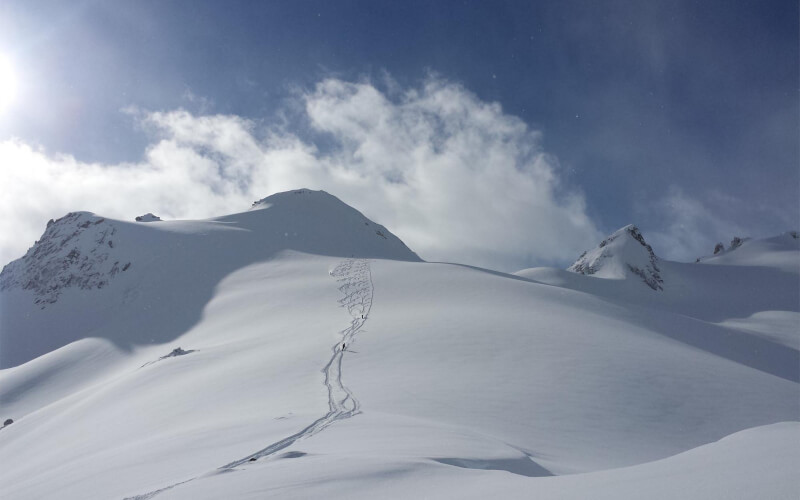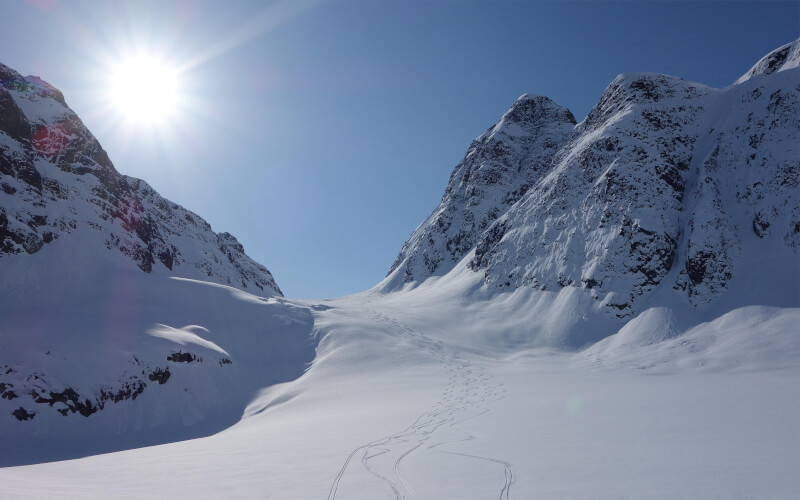Prestine wilderness, indigenous culture and out-of-this-world heli-skiing conditions collide on this epic adventure into British Columbia”s Bella Coola Valley.
As we begin our winding descent into the Bella Coola Valley, I spot the regional airport’s tiny runway, carved like a scar into the rugged landscape. Inside this chartered twin-prop plane that took off in Vancouver are eight skiers from around the world, all bound for a week of heli-skiing in one of the world’s top powder destinations. Soaring above the Coast Mountains, a white expanse punctuated by jagged peaks, I reflect on just how long I’ve waited for an adventure like this.
For a spell in my twenties, I lived in a ski town and lived to ski. Most other things – thoughts of grad school, calling home, shaving – were just distractions from my dogged pursuit of fresh tracks. Inevitably, chasing powder gave way to chasing after steady paychecks and kids. But my passion for skiing never left. So, when the opportunity to go heli-skiing came up – in Bella Coola, considered a holy grail for heli-skiers it was a chance to check off one bucket-list item I thought I’d never get to. It was also a chance to recapture a bit of my older skier self. And to take in part of the world where glaciers, rainforest and ocean converge.
Bella Coola – the name of both the small town and the valley – is located in British Colombia’s Central Coast region, in the heart of the Great Bear Rainforest. Here, winter storms roll in from the southwest, carrying moisture from the Pacific Ocean.
When this soggy air slams into the Coast Mountains, it rises, cools and, like a down pillow being ripped open, dumps snow over the peaks – lots of it (the annual snowfall here can reach 100 feet).
From the airport, we fly 30 miles by helicopter to our base for the trip, Great Bear Heli Skiing. Co-owner and host Billy Blewettt greets us on the banks of the upper Dean River under a canopy of giant cedar, fir and hemlock trees. The Blewett family helped to construct the camp’s private cabins and the main lodge, all built between 2011 and 2015 using massive local timbers. For nearly 60 years, generations of Blewetts have been guiding on the Dean River, which is renowned for steelhead trout fishing. In 2022, they expanded from casting lines in the water to chasing them in the snow by launching their heli-skiing operation.
Great Bear Heli Skiing’s exclusive alpine territory is 2,413 square miles: roughly one-quarter the size of the Swiss Alps, 190 times the size of Vail ski resort – and it’s reserved for just eight to 12 guests at any one time. Since launching operations in 2022, only a fraction of its terrain has been explored, let alone skied.
But this terrain isn’t strictly for experts: A misconception about heli-skiing is that it’s the domain of hotshot skiers, the ones in ski films jumping out of helicopters and shredding near-vertical faces. Our group varies wildly in skill level, age (from teen to septuagenarian) and thrill-seeking tendancies. Mountain operations manager Ken Bibby, our lead guide for the week, tells me his average client is between 50 and 70 years old. “The best way to think of heli-skiing, is go to any ski area and get rid of all the people,” he says, “and imagine skiing green, blue and occasionaly black runs with no moguls, no tracks, just untouched powder”.
Inside the lodge at Great Bear, the vibe is familial. With a Sitka margarita (featuring spruce-tip vodka) in one hand and bruschetta on homemade walnut sourdough in the other, I join a pre-dinner kitchen party, where guests, staff and guides mingle around the large island. I ask Ken what drew him to Bella Coola. “It’s big rivers, big mountains, big glaciers, big fish and big bears,” he says. “One of my favorite things is taking off in the lushness of a rainforest and then dropping on the top of the glacier in a totally different environment. At the end of the day, you land, and there’s the smell of the cedar trees, and moss under your feet as you walk up to the lodge. It’s that dichotomy that’s so cool.”
The morning comes early: It’s a flurry of strong coffeee (delivered piping hot in a French press to my cabin), layers of fleece and the sounds of clinking gear. Outside, the mountains are bathed in fresh light, glowing like embers. Our group climbs into two glinting A-star helicopters for the ride up over the mighty Dean River, above the trees and into the alpine.
As we hover the peaks, the view around us is all steep chutes, jade-blue seracs, yawning crevasses and ice foelds that stretch like frozen oceans. We touch down on a flat ice field section of meringue-like glacier. Gathering a safe distance from the chopper’S high-piched, whirring rotors, we cover our faces as we’re blasted with spindcrifts of icy crystals. The mechanical bird rises, then quickly banks away, disappearing behind a ridge. Silence.
We’re in avalanche country, so Ken trains us on using our avalanche beacon and lightweight shovel to stimulate a rescue. Then we’re introduced to a game-changing piece of tech in our quiver: the avalanche airbag, essentially a giant flatation device that you deploy, this should keep you bobbing atop an avalanche like a cork, rather than getting sucked under the icy wave. Ken briefs us on the protocol if we do get caught: “Try to stay on top. As the debris slows, make a last effort to reach the surface or stick a hand out,” he says. “If you can’t, create an air pocket with your hands in front of your face. Stay calm.”
I feel safe in the company of our three certified heli-ski guides, each equipped with years of professional training and a sixth sense for the vagaries of snowpacks and avalanche conditions honed from a life in the alpine. We repack our avalanche gear, switch our beacons to “locate” with a beep, and clicked into our fat skis. Ken instructs us to wait until he’s at the bottom of this section, and suddenly he’s off, carving effortlessly through the deep snow. Way, way below, he disappears over a roller. A beat later, a “hoot-hoot” echoes off the mountains, and he reappears, coming to a stop – a mere speck of yellow Gore-Tex in a sea of white. With a wave of his pole overhead, he signals the next skier – me.
Adrenaline kicks in. I push off on my skis, which look like giant tongue depressors. The snow swallows my ankles, hiding my boots, and feels as light as a whisper. Whatever skiing musclememory was stored away rushes back, familiar and instantly reassuring. I opt for wide, surf-like turns, letting the skis do most of the work. My heart is pounding. A nearal storm of dopamine is unleashed. I’m sure my pupils are as large as frisbees.
This is the longest, most uninterrupted powder run of my life, slicing through the best snow I’ve ever skied. I come to a sharp stop right before Ken, fully covering him with a spray of Bella Coola sugar. The “hoot-hoot” I bellow out matches his. The tone of the day is set.
In one giant bowl, with views of the Dean Channel reaching out into the open ocean, our group skis down in tandem. We’re careful not to cross each other”s tracks – a big no-no in heli-skiing. We have behind lines in parallel. Each ride back up, in the company of new friends, feel like a competition to see whose smile is the widest. By day’s end, we’ll haves lied 20,000 feet of vertical.



